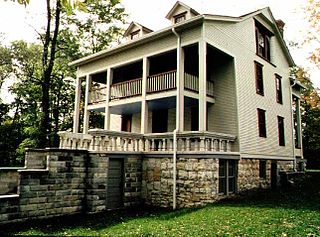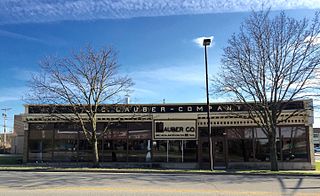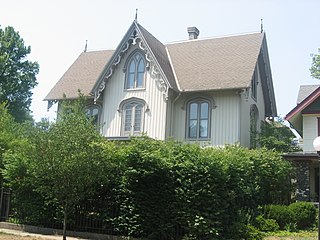
The James Whitcomb Riley Museum Home, one of two homes known as the James Whitcomb Riley House on the National Register of Historic Places, is a historic building in the Lockerbie Square Historic District of Indianapolis, Indiana. It was named a National Historic Landmark in 1962 for its association with poet James Whitcomb Riley (1849-1916), known as the "Hoosier poet".

The William H. Roberts House is a late 19th-century house located in Pecatonica, Illinois, United States. The house was built in 1883 for Dr. William H. Roberts, who died three years later at the age of 33. The building features a combination of elements from three distinct architectural styles, Italianate, Queen Anne and Gothic revival. The building functioned as both Roberts's house and office. The house is the only building in Pecatonica listed on the United States National Register of Historic Places, a status it attained in 1979.

The Union House, also known as the John Bower House, is a small, mostly Gothic Revival house in downtown Orangeville, Illinois, United States. The house, the first brick home in Orangeville, was built in 1849 by village founder John Bower. It was purchased by Samuel Hutchins in 1885 and it remained in the Hutchins family until 1951. The house blends elements of Greek and Gothic Revival architecture and is the only example of Gothic Revival found in the village of Orangeville. The house was added to the U.S. National Register of Historic Places in 2000.

The Joseph Bailly Homestead, also known as Joseph Bailly Homestead and Cemetery, in Porter, Indiana, is a U.S. National Historic Landmark.

Morris Performing Arts Center is a 2,564-seat concert hall located in South Bend, Indiana. It opened in 1922 as a vaudeville house and later became a movie palace. It was developed along with the neighboring Palais Royale Building by the Palace Theater Corporation. It is a four- to five-story, rectangular, Spanish Renaissance Revival style brick building with finely crafted terra cotta ornamentation. It was planned for demolition in 1959 but was saved from demolition, and between 1998 and 2000, it was restored and remodeled.

The Lane Place was the home of Sen. Henry S. Lane and Joanna Lane (1826-1914). It is located at 212 South Water Street in Crawfordsville, Indiana. Helen Elston Smith, the Lanes' niece, inherited the house after Joanna's death. She willed the house and its contents to the Montgomery County Historical Society on February 26, 1931. 85%-90% of all of the furnishings are either original to the house or belonged to the Elston Family. The house has been a museum since 1931 even though Helen continued to live in the home until the mid-1930s.

Ruthmere, formerly the Albert and Elizabeth Beardsley Residence, is a three-story Beaux-Arts mansion that is the most prominent historic residence in Elkhart, Indiana, United States. Built in 1910, the Ruthmere Mansion is now open to the public as a museum, along with the neighboring Dr. Havilah Beardsley House.

This is a list of the National Register of Historic Places listings in St. Joseph County, Indiana.

The Rufus M. Rose House is a late Victorian, Queen Anne style house located in the SoNo district of Atlanta, Georgia. Occupying a narrow lot on Peachtree Street, one and half blocks south of North Avenue, the house was built in 1901 for Dr. Rufus Mathewson Rose. The architect was Emil Charles Seiz (1873-1940), who designed many residential and commercial structures in the city, including the 1924 Massellton Apartments on Ponce de Leon Avenue.

The Dr. Kuno Struck House, also known as Clifton Manor, is a historic building located in the West End of Davenport, Iowa, United States. It was individually listed on the National Register of Historic Places in 1984, and on the Davenport Register of Historic Properties in 1996. The house, along with its garage, became a part of the Marycrest College campus and they were both listed as contributing properties in the Marycrest College Historic District in 2004.

Povey Brothers Studio, also known as Povey Brothers Art Glass Works or Povey Bros. Glass Co., was an American producer of stained glass windows based in Portland, Oregon. The studio was active from 1888 to 1928. As the largest and best known art glass company in Oregon, it produced windows for homes, churches, and commercial buildings throughout the West. When the firm was founded in 1888, it was the only creative window firm in Portland, then a city of 42,000 residents.

The I & M Building, also known as Colfax Place, is a historic building located at 220 W. Colfax in South Bend, Indiana. It is located next to the Commercial Building. The building, which was built in 1929, originally housed the offices of the Indiana and Michigan Electric Company. The Art Deco building was designed by Austin & Shambleau. The seven-story building is faced in marble on its front first story, limestone on the remainder of its front, and brick on its sides. Terra cotta separates the building's front center windows through the fifth story, while stone with terra cotta features separate the side windows. The building is one of the few Art Deco structures in South Bend and the only "pure" example of the style within its downtown business district.

The Beiger Mansion, pronounced By-gur, though known more colloquially as Bee-gur, was the palatial home of Martin Valentine and Susie Higgins Beiger at 317 Lincoln Way E. in Mishawaka, Indiana. In 1973 it was added to the National Register of Historic Places. Built in 1903 the home was burned to the ground in 1975 and has since been restored, though not to its former grandeur. The restoration process is still ongoing. It is now operated as a bed and breakfast and event facility.

The William B. McCallum House, built in 1887, is an Italianate Style house in Valparaiso, Indiana contains many of the basic elements of Italianate design, including brick masonry, deep eves, thick cornice features of wood and protruding flattened arch brick window lintels and a two-story bay window.

The Italianate House at 608 Academy Street, Valparaiso, Indiana was constructed by Conrad and Catherine Bloch in about 1873. The double-pile brick house has a commanding presence on a double lot at the corner of Park and Academy Streets. A brick woodhouse dates to about the same period as the house. The garage dates from about 1940. The house was converted to the Valparaiso Hospital and Sanitarium by Dr. Harvey Cook in about 1923. It has been converted back to a single family home.

The J.C. Lauber Company Building is a historic building on the east side of South Bend, Indiana. The building was added to the National Register of Historic Places in 1999. The company produced much of the sheet metal and roofing for buildings in early-20th-century South Bend.

Morey House is a historic apartment house located at South Bend, St. Joseph County, Indiana. It was built in 1909, and is a large 2+1⁄2-story, building with a brick first story and stuccoed upper stories in an American Craftsman vernacular style. It has an irregular plan and features two small square porches with balconies on the corners of the front facade.

The Horatio Chapin House, or simply, the Chapin House, is a historic home located at South Bend, St. Joseph County, Indiana. It was built between 1855 and 1857 by Horatio Chapin, one of the early settlers of South Bend and the first president of the board of town trustees. The house consists of a 2+1⁄2-story, cross-plan, Gothic Revival style frame dwelling, a rare example of its kind in the region. It's considered an outstanding example of Gothic Revival architecture influenced by architect Andrew Jackson Downing. It is sheathed in board and batten siding and features lancet windows and a steeply pitched cross-gable roof with an elaborately carved bargeboard. The Chapin House is widely recognized as one of the most significant homes in the state of Indiana, and in 1980 it was listed on the National Register of Historic Places.

West Washington Historic District is a national historic district located at South Bend, St. Joseph County, Indiana. It encompasses 330 contributing buildings in an upper class residential section of South Bend. It developed between about 1854 and 1910, and includes notable examples of Italianate, Greek Revival, and Romanesque Revival style architecture. Located in the district are the separately listed Morey-Lampert House, Oliver Mansion designed by Lamb and Rich, Second St. Joseph County Courthouse, South Bend Remedy Company Building, and Tippecanoe Place. Other notable buildings include the Bartlett House (1850), Birdsell House (1897), DeRhodes House designed by Frank Lloyd Wright, Holley House, Kaiser-Schmidt House, Listenberger-Nemeth House, Meahger-Daughterty House (1884), O'Brien House, Oren House, The People's Church (1889), St. Hedwig's Church, St. Patrick's Church (1886), St. Paul's Memorial United Methodist Church (1901), West House, and a row of worker's houses.

St. Philip Neri Parish Historic District is a historic Roman Catholic church complex and national historic district located at Indianapolis, Indiana. The district encompasses five contributing buildings: the church, rectory, former convent and school, school, and boiler house / garage. The church was built in 1909, and is a Romanesque Revival brick church with limestone trim. It features two- and three-story crenellated corner towers, a rose window with flanking round arched windows, and Doric order columns flanking the main entrance.

























